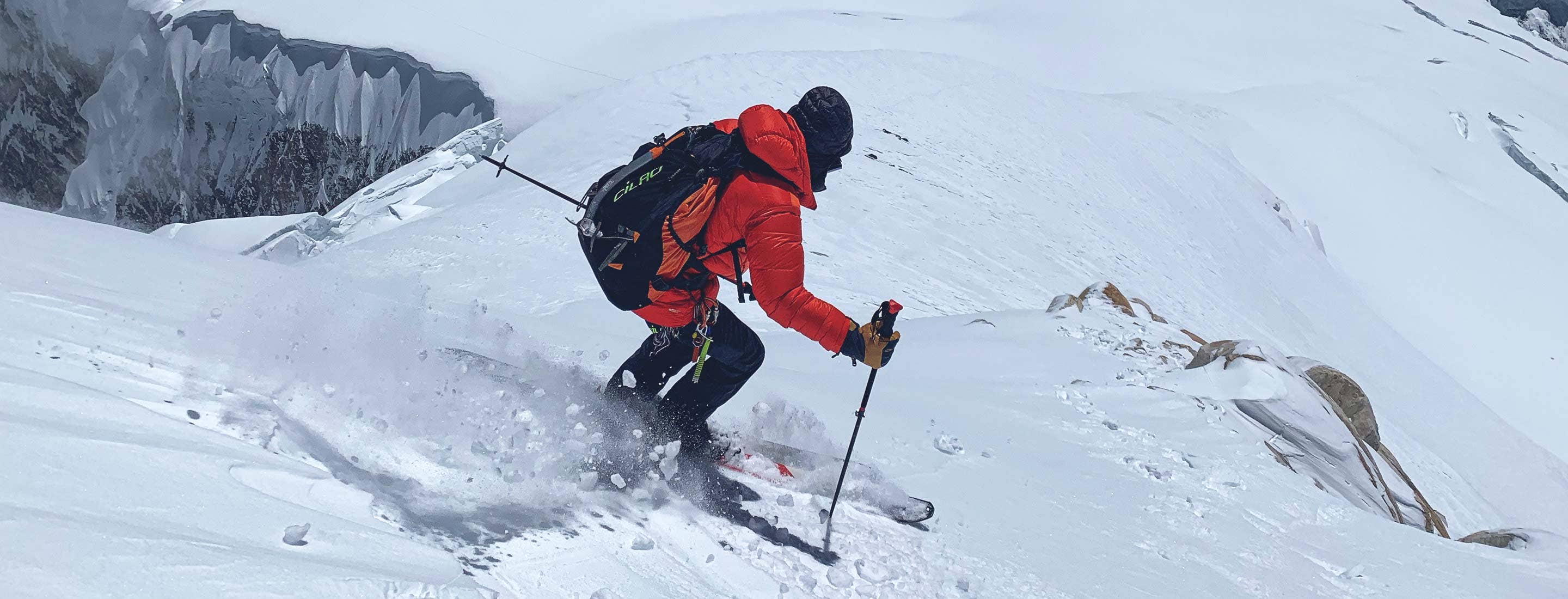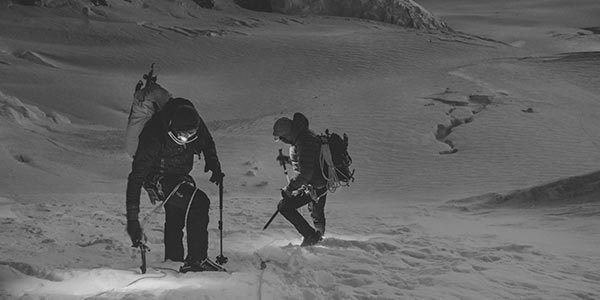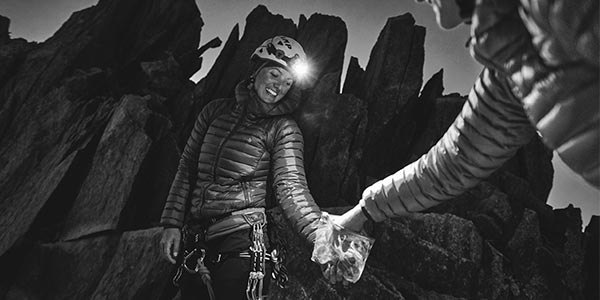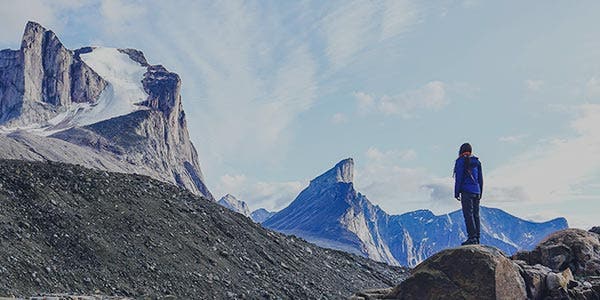

In our 70s, pink candy-coloured Land Cruiser, it looks more like heading out from a summer camp. Our driver, as comfortable behind the wheel as he is on the turntables, happily shares with us his local playlist. In the back seat, smiling, Nuawas, Muaz and Nazir enthusiastically accompany the words (they take care of our logistics and, in particular, our kitchen at base camp). Rocked by the road and the landscapes that pass by, I watch the scene just happy to be back in Pakistan..
June 16, 2019, with logistics settled, permits issued and jeep loaded, our first part of the expedition can begin. Direction village of Arando in the Shigar valley.
In our 70s, pink candy-coloured Land Cruiser, it looks more like heading out from a summer camp. Our driver, as comfortable behind the wheel as he is on the turntables, happily shares with us his local playlist. In the back seat, smiling, Nuawas, Muaz and Nazir enthusiastically accompany the words (they take care of our logistics and, in particular, our kitchen at base camp). Rocked by the road and the landscapes that pass by, I watch the scene just happy to be back in Pakistan.


Over the next couple of days, we spent some time in the bigger mountains and despite the wind depositing snow in some scary places, we still managed to get a good amount of climbing done that wasn’t too dangerous. Having said that though, we did decide to back off of one of our objectives, as the whole face was glazed in a hard layer of thin verglas ice, which made the climb too hard and dangerous to protect and stay safe. We weren’t there to be heroes or get hurt, just to climb and have fun, so we felt that descending was the only option!
After this, the storms came in hard and we managed to find a fun area that had a load of unclimbed routes available to play on, but thankfully it was also very protected from the surrounding avalanches that were releasing periodically throughout the valley. Over the next two days, Jeff and I climbed two very good lines on the face. One was a steep fragile ice route that forged its way up the vertical dark wall. Jeff dispatched this will little fuss, apart from the odd grunt when the heavily dripping ice went straight down his exposed neck. I'm sure I told him to put his hood up?! He called the route ‘La Tournée du Poltron’ (The Tour of The Coward), a 40m WI5+.






June 20 to 23, we get to work! The classic duo, spotting and acclimatisation, begin. We go directly to explore the valley next door, to establish a camp around 4700m. We quickly spot several objectives in the mountains between 5000 and 6000m. After skiing for three days, triggering a few avalanches, collapsing a cornice the size of a small building and ascending two summits, we go back to base camp. Our feelings are mixed. The snow is unstable in all exposures and has an unfortunate tendency for slab avalanches under our skis. We are a little worried about what’s to come on the Spantik.
June 24 to 26, bad weather, we are stuck at the base camp. For three days, we indulge in our favourite routine; sleep, eat, watch series and start over!
The time between the end of our guide season and the departure to Pakistan was short, we are happy to be able to rest.
June 27 to 31, departure! Neige and Vincent, our weather routers from France, announce a five-day window of good weather. The conditions have most likely not improved with the last snowfall, but we hope it will improve with the good weather and heat forecasted. We decide to leave. The route to camp 3 is not exposed, it follows the long southern ridge that leads to a plateau at 6400m. It is easy to climb safely.
In two days, we reach our camp 2. It has put our nerves to the test. The ridge we followed was not exposed, but the scene was impressive. Making the tracks was not dangerous, but a little stressful. To the left, a cornice that could give away anytime and to the right, the slope very prone to avalanches. For the one who advances second, it is a beautiful atmosphere. They can appreciate the landscape and the spectacle of the avalanches triggered by the leading partner.
On the third day, between camp 2 and camp 3, things get more complicated, and we are sceptical about what to do next. The ridge turns into a snow dome, it is difficult to stay on the ridge, we are forced to go up the middle of the slope. Fortunately, the consistency of the snow has slightly changed. We sink to mid-thigh, but the snow is more stable. Despite the relative ease of the track, we arrive at Camp 3 tired after a long day due to uncertain and changing conditions.








June 30, "summit day", after a poor night’s sleep at altitude, we leave our camp around 5am and join a large plateau and the final summit push. Snow conditions are crucial for a successful summit ascent. This time, luck is on our side. By slightly bypassing the ridge from the west, we find a shoulder optimal for climbing. The snow is compact and worked by the wind, without risk of avalanche. We are relieved. All that remains is to keep walking at the frantic pace of a hundred vertical metres per hour.
It is 1pm, the sun is shining, no wind, we are at the top of the Spantik. The atmosphere is peaceful. Tired but happy, we enjoy the summit and the mountains that continue as far as the eye can see. Pakistan is truly unique.
On the descent, we offer ourselves a little pleasure on the upper part, a direct line in the middle of the seracs. The snow is good and the setting is magnificent under these huge ice towers. It is with big smiles and small turns that we reach our camp. The desire to go down directly to the base camp is very tempting, but we do not give in to the easy way. One more poorly slept night at camp 3 will be ideal to perfect our acclimatisation. We are already thinking about Nanga!
On June 31st, after fully enjoying the descent on the very picturesque Spantik ridge, we reunite with our friendly team at base camp. Coca colas, French fries, cake, songs and dancing. We are celebrating the summit in Pakistani style. Our first objective was a success; we skied the Spantik!




Part 2
June 1 to 7 is a transition. After two days, we arrive back in Skardu. For one night and a quick wash, we hit the road again for a short weekend in Gilgit. It's Eid, the end of Ramadan, the country lives in slow motion. We have to wait a day to do some shopping and prepare for the rest of the adventure. We are also changing guides, this time it is Fakir of Shilaz who will accompany us.
June 8 to 9, heading for the Nanga Parbat base camp. Change of valley, change of scenery. This region is much more conservative than the Skardu region. In Shilaz, the starting point for the Nanga trek, the men have long beards and women, already rather discreet in the Skardu, are invisible here. After two days, escorted by our policeman, we reach our base camp. The place is magical, with some grass and the 4000m face of Nanga in the background. At camp, two teams are already present. Two Georgian climbers and a Russo/Italian team, where we also find Cala Cimenti who ascended the Laila Peak last year just after us. The Russo/Italian team will also attempt a ski descent. Conditions on the Diamir face seem good and our excited little brains are already beginning to dream of a direct line in the middle of the face.
June 10, verification. For our first day, we head to camp 2 to have a look at the famous Kinshofer wall. It is a 150-metre vertical wall, the most technical passage of the ascent. We climb the first 50 meters and fix our rope for this part. From here, we can see the rest of the wall and in particular, the remains of the many fixed ropes! By sorting and selecting a little, some ropes are still in good condition making it easy to climb during our summit attempt. This is the only place where we will use fixed ropes. We turn around and ski the beautiful slope that leads us back to Camp 1 and at 3pm we are back at the base camp.
June 11 to 15, struggle, my doubts of the day before are confirmed, Pakistan finally takes a grip of my stomach. The real battle begins. Tyorfan, Imodium, Georgian medicine... everything goes down but nothing works. I feel Tiphaine's worried look at my physical condition. It is only on the fifth day and after taking antibiotics that an end to this battle seems to near. Meanwhile, a snowstorm has hit with more than 80 cm deposited at base camp. The face of the Nanga has been well swept clean by the wind and now shines an icy surface. Our dreams of a direct skiable line seem to be waning.


June 15 to 20, towards the Diama face. This morning, my condition is average but with a little optimism, in a few days, I will be back to normal. To finish our acclimatisation, we want to go up one more time to 7000m. To avoid an annoying round trip on the normal Kinshofer route and to spot a possible descent line, we go to the isolated side of the Diama. The weather is changing, but never anything very bad. The snow conditions are reassuring, we enjoy playing in the middle of the monster. On the fourth day, ascending by a route maybe never done before, we are at 7500m almost at the top of the Diama face. From here, we can reach the normal route, which gives us one more option for the descent of the Nanga. One last night at 6600 meters and we return to base camp. After this short trip to the heart of the Diama, for us, the expedition is already a success!
June 21 to 25, rest while waiting for a good weather window, our acclimatization is over! At base camp, two new expedition teams have arrived, including Nims Dai and his crazy project to climb the fourteen 8000m mountains in seven months. We talk a little with the other groups about the rest of the program. For us it is obvious; at the first favourable weather window for a summit attempt, we will take off. And if we can climb the mountain alone, it's even better!
On the 23rd we have the chance to enjoy a little entertainment with the arrival of two helicopters, as we are the reason for their coming! A team from TF1 (a French television channel) has come to report on the Nanga and our adventure.
However, there is no time to take advantage of our growing reputation! Our forecasters are watching over our shoulders. It seems that a window of opportunity is opening around the 29th, we shouldn't miss it.




June 26 to July 2, Nanga Parbat, we leave the base camp at 4am. We have to re-make the tracks between camp 1 and camp 2. Climbing the Kinshofer with our big bags and skis on our backs is more like weightlifting than a climb. After 11 hours of effort, we reach camp 2 directly. Here, some members of the other expeditions are fine-tuning their acclimatisation. We can benefit from the work done by the Georgians to make a nice terrace for our tent, more than an hour’s effort saved. Tonight, karma is average. Tiphaine realises that she has forgotten our first aid kit. Fortunately, our Spanish and Brazilian friends, present at the camp, help us out with a few pills. Vincent, our weatherman, is now less optimistic about the good weather window on the 29th. The good weather seems to be near the 4th of July. The weather forecast for the next few days looks much like the weather during the past week; very nice in the morning, slightly overcast and a little snow in the afternoon, but never very bad. We have to make a decision. The idea of descending back to base camp and leaving at the same time with the other teams does not please us. Climbing with 15 people in a single file is no longer the same mountain nor the same adventure. Without really discussing, we opt to continue the ascent.
June 27, we leave camp around 6am and ascend the first part of the ridge, along tracks made Pakistani porters the day before. After 200 meters, we reach a large virgin slope. The snow, deep at first, soon gives way to ice as we progress. In fog and snow, we reach Camp 3. Soon, the sun quickly returns. When I put up the tent, a hoop escapes my hand and takes a great flight over the face. We only have half a tent left. Fortunately, approaching the edge of a serac, Tiphaine sees the flying hoop and brings it back to the tent. Phew, the expedition is saved!
From camp 3 to camp 4, the track is strenuous. It is necessary to zig-zag to avoid large snow accumulations and go up the steep slope. The task is made easier with the skis on. We cross the large plateau that leads us to camp 4, sheltered behind a small serac. We are at 7250m, it is 7pm. Setting up the tent and melting water takes us 3 hours. It is only around 10pm that we can enjoy a well-earned rest.






June 29, waking up at 3:30 am. As surprising as it may seem at 7250m, we slept like babies. We start the march around 5am. Moving at less than 100 vertical meters per hour, everything seems far too far away. Our spirits are shaky. Around 1pm, the sun gives way to a few clouds. We continue our long ascent. Making the tracks requires a lot of tenacity. Tired, Tiphaine won't give up. Around 6pm, we are at more than 8000 meters. I continue a little longer, my phone indicates 8040 meters. Visually, the summit seems out of reach. Tiphaine has stopped moving. It is late, the weather is average, I also give up. I find her a little lower down. By the time to prepare for the descent, it is already dark. As a make-do headlamp, we use our smartphones. We descend in a rather unique style. Lying on the snow to one side, we let our skis drift along our ascent tracks. Around 9pm, we are at camp 4. Tired but not exhausted, we are already thinking about the next step. We have to try again. Our late departure certainly sabotaged our chances of success.
June 30, rest day at 7250m. The day is spent making water, telling stories and repairing my ski boot that broke during the descent. With an ice screw, I can make two holes in the shell and pass a cord through to lock the shoe in the ski position. The mood is good, and without moving in our sleeping bags, we don't even feel the altitude!
July 1, alarm at 00:30 am. After having spilt half of the breakfast in the tent, melted some snow again, preheated the ski boot liners…it is only around 3:30 am that we manage to set off. Our new record for preparing! The tracks need to be re-done with new snow and wind. Our pace is depressing. We alternate taking short turns with Tiphaine to move forward. We are at 7800 meters. Until now, we walked together. I slightly separate myself from Tiphaine in a rocky part. She tells me she's stopping there and that she will wait for me. I’m a little surprised, as she seemed to be in good shape until now, I suggest she go down to our camp instead. She insists on waiting for me in a hole behind a rock. My brain, a little foggy, is taking this pretty lightly.
Without real confidence, just to see what will happen, I continue my ascent. I am more than 8000m high and I have just passed the point where we turned back two days earlier. The brittle and deep snow has now given way to a hard base. I am progressing at a good pace and for the first time, the summit seems accessible to me.






I keep an eye on the clouds rising from the valley. There is a lot of wind. I am focused and determined. Around 8080m, I reach a small pass just to the left of the summit. I leave my skis and finish by a rocky ridge. It is 5:27 pm. The wind blows hard, between shadows and lights I am at the top of Nanga Parbat. Without Tiphaine, the emotion is a little less intense, no tears this time. It's just immeasurable to be here. A selfie, a tour of the horizon, I descend to my skis. I put my skis on at 8080m. On the way down, I pick up Tiphaine huddled in her hole. We hug and are relieved to be together again. Even if our legs no longer really respond, the descent is incredible. The sun is shining, the sky is on fire, the light is magic.


At 7pm we are back at camp 4
July 2, after waiting for the sun to warm our tent, we are slowly getting ready. Tiphaine is more courageous. Lazy, I'm beginning to feel the altitude. Around 1pm, we start the descent. Our initial idea of going up the 200 meters to find the route to descend the Diama, is quickly abandoned. Four nights at 7250m have exhausted our last energy reserves. We go down the normal route, again. Between camp 3 and camp 4 we cross the other expeditions with Nims Dai and his team leading. Under camp 3, the ice is covered with only a thin layer of snow. In a moment of confidence, I take my last turn that finishes in a long slide on the blue ice. We decide to hold the fixed ropes to pass the critical 100 meters. To avoid the Kinshofer wall, we use a variant located on the right of the wall. Skied by Luis Stitzinger in 2007, we spotted the route from the base camp.
We are tense. We are in a cloud and visibility is zero. The ice is lingering, the route is not that simple. The last effort and the first dispute about the route, we find the ramp that allows us to reach the lower part of the Kinshofer. The end of difficulties. We take advantage of our last turns on the Nanga and reach the bottom of the glacier. Muaz and his Coca Cola are waiting for us, we skied the Nanga!
A mitten, an ice axe, a helmet and a few thermoses later…two months living in a tent are coming to an end. We were able to enjoy beautiful summits spiced with long stays at altitude. This experience has allowed us to practice alpinism as we like it, alone and according to our desires and conceptions. The good times spent with our team, the porters and the Pakistanis, in general, have largely contributed to keeping our motivation high. The long days of rest at base camp contrasted with the intense efforts in the mountains are the richness of this adventure. In short, this trip is a success on all levels. We are eager to return home, to enjoy the summer in France before dreaming of the next expedition.


Words by | Boris Langenstein




